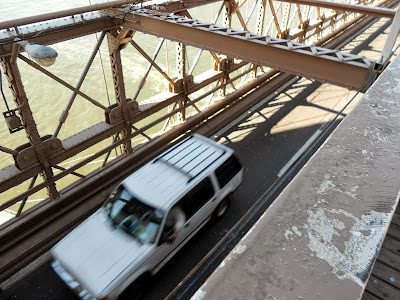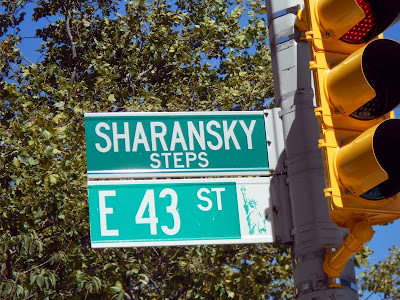Today was going to be a BIG walking day, and so it turned out!
Empire State Building
Another one of those iconic places you just
have to go to in NY.
Completed in 1931, well under budget and built in just 14 months, the Empire State Building occupies what had originally been the site of the first Waldorf-Astoria Hotel (see blog for 19 September) since 1893. Despite having 102 storeys and standing 1454 feet high, its height is so deceptive we stood on Fifth Avenue practically underneath it without noticing it was there.
The building has seen its share of celebrity and tragedy:
- King Kong clung to it while grabbing at passing aircraft
- in 1945, a B-25 bomber crashed into the 79th floor, killing 14 people
- in 1979, 2 Englishmen parachuted from its summit to the ground, to be promptly arrested
- in 1997 a man opened fire on the Observation Deck, killing 1 tourist and injuring 7 others
- in 2010 a Yale student scaled the barrier on the Observation Deck and jumped to his death.
The guide book had advised pre-booking tickets, which you can then use on any day and at any time, to avoid the queues and, even though we were going at the end of the 'season', it proved to be very sound advice. That said, once inside, the queues for the first lift (to the 80th floor) were still lengthy.
As soon as we exited the lift at the 80th floor we saw some splendid examples of Art Deco .....
.... as well as a small but informative series of exhibits about the men who had toiled on the construction of the building.
Then back into a lift for the ride to the 86th floor.
The views from the outdoor walkway were as stunning as we had hoped.
From up here we could see our next stop: Macy's.
Calling itself 'the world's largest store', the building went up in 1902 and takes up an entire block, offering about
two million square feet of selling space
. We rode to the 7th floor coffee shop. The first three floors had the fashionably upmarket look and feel we had expected, but from there up the drab displays of cheaper utilitarian goods, the shabby decor and the (presumably) original wooden escalators were evidence of the store's continued failure to recover from its economic crisis and bankruptcy of 1990-1992.
Times Square
Times Square took its name from the
New York Times newspaper which built its offices here in 1904. Not actually a square at all, it is formed by the intersection of Seventh Avenue and Broadway. Traditionally it was the place where out-of-towners provided easy pickings for petty criminals, drug dealers and prostitutes but today its legendary pornography and crime has largely been replaced by superstores, high-rise office buildings and boutique hotels.
It's a moving mass of people and neon signs pulsate everywhere you look. You either love it or hate it. Quiet and under-stated it's not!
Rockefeller Centre
From Times Square we walked up Sixth Avenue, which more or less separates the business and theatre sides of Midtown New York. The block between 49th and 50th streets houses the Rockefeller Centre, built between 1930 and 1939, and now home to much of America's entertainment industry including the NBC studio.
On the north east corner of Sixth Avenue and 50th Street is the Art-Deco style
Radio City Music Hall, arguably the most famous theatre in the US.
We continued walking up Sixth Avenue and were pleasantly surprised to find
Bryant Park. Apparently, a few decades ago it was a seedy eye-sore but, like much of New York, has been transformed. Today it's a pleasant green space filled with trees, flowerbeds and inviting chairs. Nothing more strenuous than relaxation was going on on the warm Wednesday afternoon we were there, but in summertime there are a host of free activities on offer while in winter the park's Citi Pond turns into an ice-skating rink.
Just behind Bryant Park is the hundred-year-old
New York Public Library, faced in white marble and Beaux Arts in style. It's the HQ of the largest public library system in the world.
This corridor gives an idea of the scale, opulence and style of the interior.
Unfortunately we couldn't take pictures in either the Map Room, or the 636-seat Reading Room on the third floor where Leon Trotsky studied just before the Russian Revolution in 1917.
Grand Central Terminal.
This has been on the 'must see' list since a visit to New York was first mooted. The scene of so many movies, we just had to see it for ourselves!
http://www.thedailybeast.com/videos/2013/02/01/grand-central-through-the-movies.html
This massive terminal sits on Pershing Square, where Park Avenue meets 42nd Street.
The original station was built by Cornelius Vanderbilt on the site , but after the electrification of the railways made it possible to reroute trains underground the rail lines behind the existing station were sold off to developers and the profits went towards the building of a new massive terminal, built in 1913.
 |
| Centenary celebrated in window display. |
Grand Central clearly represents a time when stations were seen as miniature cities. Today its traffic consists mainly of commuters (up to 500,000 a day) speeding out to Connecticut, Westchester County and upstate New York.
The station's
main concourse is '
one of the world's most imposing open spaces' (Rough Guide), 470 feet long and 150 feet high.
The
barrel-vaulted ceiling is speckled like a Baroque church with a painted representation of the winter night sky, its 2500 stars shown back to front - '
as God would have seen them', the French painter Paul Hellen reputedly remarked.
We took an audio tour which was an excellent way to get to grips with what we were looking at and not get side-tracked by the sheer scale and opulence of the place. The chandeliers and marble would not have been out of place in an exclusive hotel.
At first glance these seemed just like windows, but then we saw people walking across them. A walkway had been built between two sets of windows to enable access between the station and adjoining offices.
Mention Grand Central to any movie-buff and they'll think of the magnificent staircases that have figured in so many films. The west stairway was completed in the 1920s, the steps being pink marble from Tennessee and the balustrades Italian marble. For some reason, the east stairway was not then built and it wasn't until the 1990s that they decided to go ahead, by which time the Tennessee quarries had been long closed so they had to be specially reopened.
Downstairs is the bustling
Dining Concourse, furnished with the original oak benches that had provided seating for 500 in the upstairs Waiting Room of the pre-1913 building: an excellent example of recycling. Luggage racks from early 20th century trains have been used here too to give the space the look and feel of a railway compartment.
Chief among the eateries downstairs is the
Grand Central Oyster Bar (steamed Maine lobster priced by the pound, oysters $2.95 each) in the vaulted bowels of the station. Renowned for its food certainly, but also for its
Whispering Gallery: because of the arrangement of the tiles that line its walls and ceiling ....
......by an acoustic fluke, two people can stand on opposite sides of any of the vaulted spaces and hold a conversation. we tried it and it works!!













































































